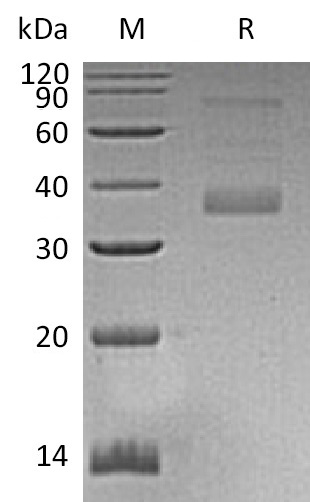Shopping Cart
- Remove All
 Your shopping cart is currently empty
Your shopping cart is currently empty

Microfibril-associated glycoprotein 4(MFAP4) is a secreted protein and contains 1 fibrinogen C-terminal domain, similarity to a bovine microfibril-associated protein. The protein has binding specificities for both collagen and carbohydrate. It is thought to be an extracellular matrix protein which is involved in calcium-dependent cell adhesion or intercellular interactions. The gene is located within the Smith-Magenis syndrome region.

| Pack Size | Price | Availability | Quantity |
|---|---|---|---|
| 10 μg | $60 | 7-10 days | |
| 50 μg | $184 | 7-10 days | |
| 500 μg | $894 | 7-10 days | |
| 1 mg | $1,300 | 7-10 days |
| Biological Activity | Activity has not been tested. It is theoretically active, but we cannot guarantee it. If you require protein activity, we recommend choosing the eukaryotic expression version first. |
| Description | Microfibril-associated glycoprotein 4(MFAP4) is a secreted protein and contains 1 fibrinogen C-terminal domain, similarity to a bovine microfibril-associated protein. The protein has binding specificities for both collagen and carbohydrate. It is thought to be an extracellular matrix protein which is involved in calcium-dependent cell adhesion or intercellular interactions. The gene is located within the Smith-Magenis syndrome region. |
| Species | Human |
| Expression System | HEK293 Cells |
| Tag | C-6xHis |
| Accession Number | AAH62415.1 |
| Synonyms | Microfibril-associated glycoprotein 4 |
| Amino Acid | Val22-Ala255 |
| Construction | Val22-Ala255 |
| Protein Purity | Greater than 85% as determined by reducing SDS-PAGE. (QC verified)  |
| Molecular Weight | 37 KDa (reducing condition) |
| Endotoxin | < 0.1 ng/µg (1 EU/µg) as determined by LAL test. |
| Formulation | Lyophilized from a solution filtered through a 0.22 μm filter, containing 20 mM PB, 150 mM NaCl, pH 7.4. |
| Reconstitution | Reconstitute the lyophilized protein in distilled water. The product concentration should not be less than 100 μg/ml. Before opening, centrifuge the tube to collect powder at the bottom. After adding the reconstitution buffer, avoid vortexing or pipetting for mixing. |
| Stability & Storage | Lyophilized powders can be stably stored for over 12 months, while liquid products can be stored for 6-12 months at -80°C. For reconstituted protein solutions, the solution can be stored at -20°C to -80°C for at least 3 months. Please avoid multiple freeze-thaw cycles and store products in aliquots. |
| Shipping | In general, Lyophilized powders are shipping with blue ice. Solutions are shipping with dry ice. |
| Research Background | Microfibril-associated glycoprotein 4(MFAP4) is a secreted protein and contains 1 fibrinogen C-terminal domain, similarity to a bovine microfibril-associated protein. The protein has binding specificities for both collagen and carbohydrate. It is thought to be an extracellular matrix protein which is involved in calcium-dependent cell adhesion or intercellular interactions. The gene is located within the Smith-Magenis syndrome region. |

Copyright © 2015-2025 TargetMol Chemicals Inc. All Rights Reserved.